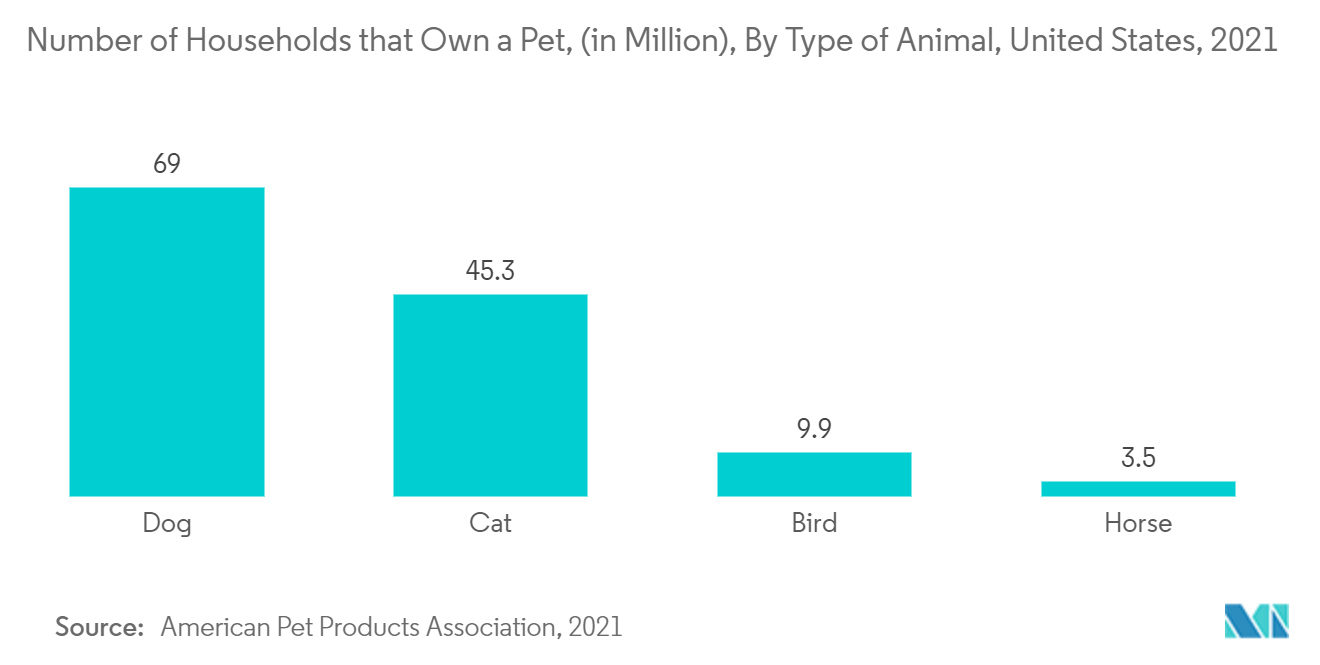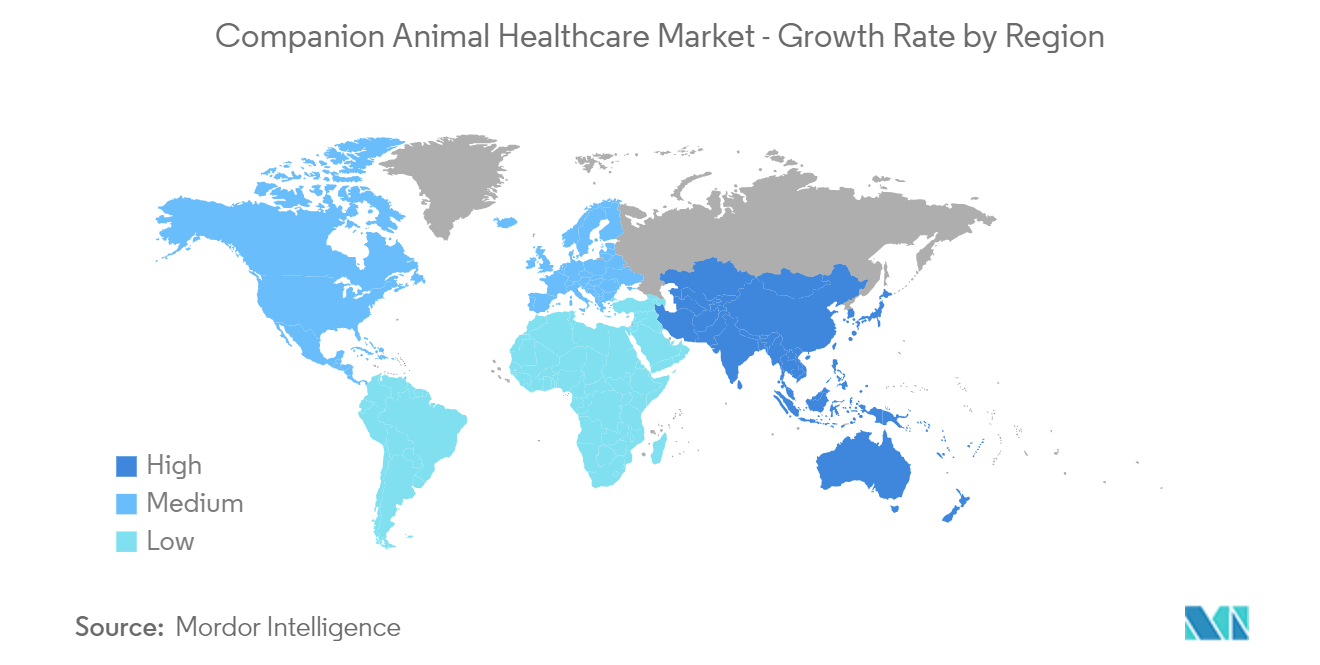Market Trends of Companion Animal Healthcare Industry
This section covers the major market trends shaping the Companion Animal Healthcare Market according to our research experts:
Vaccines Segment is Expected to Grow at a Significant Rate Over the Forecast Period
The vaccines segment is expected to witness significant growth in the companion animal healthcare market over the forecast period owing to factors such as the rising prevalence of zoonotic and chronic diseases, increasing product launches, growing awareness of animal health, rising investments by government bodies and associations, and increasing healthcare expenditure for companion animals.
Vaccines are comprised of viruses, bacteria, or other disease-causing organisms that have been killed or altered so that they cannot cause any disease but can boost immunity. New advanced vaccines have been manufactured containing genetically engineered components derived from those disease agents.
Additionally, the increasing number of cases of rabies across the globe is one of the major factors driving the market's growth over the forecast period. For instance, according to the data published by WHO in May 2021, dogs are the leading cause of human rabies mortality and account for up to 99.0% of all human rabies transmissions. Vaccination is important for companion animals as it not only safeguards them from epidemics but also protects owners in case of any animal bites.
Furthermore, market players are developing and launching new vaccines globally to enhance their market presence, which is also contributing to the segment's growth. For instance, in March 2021, the world's first animal vaccine against the novel coronavirus was registered in Russia, named Carnivac-Cov, which is developed by a unit of Rosselkhoznadzor (Federal Service for Veterinary and Phytosanitary Surveillance). The clinical trials of Carnivac-Cov involved dogs, cats, and other animals.
Also, in June 2022, in India, the Union Minister of Agriculture and farmers' welfare, Shri Narendra Singh Tomar launched animal vaccines and other diagnostic kits developed by the ICAR-National Research Centre on Equines. The Ancovax Vaccine on Equines is an inactivated SARS-CoV-2 Delta (COVID-19) Vaccine for Animals. The immunity induced by Ancovax neutralizes both Delta and Omicron Variants of SARS-CoV-2. The vaccine contains inactivated SARS-CoV-2 (Delta) antigen with Alhydrogel as an adjuvant.
Moreover, in September 2022, Merck Animal Health announced on World Rabies Day that it has donated around five million doses of its NOBIVAC rabies vaccine to help eliminate canine-mediated rabies. Through its Afya Program, Merck donated the vaccines to key partners such as Mission Rabies and Rabies Free Africa, who administer the vaccine to dogs via mass vaccination campaigns across the world. Development such as these ultimately lead to market growth.
Thus, owing to the above-mentioned factors, the studied segment of the companion animal healthcare market is expected to grow significantly over the forecast period.

North America Dominates the Market and Expects to do the Same Over the Forecast Period
North America is expected to dominate the companion animal healthcare market over the forecast period owing to factors such as the rising adoption of companion animals, growing awareness among pet owners about pet healthcare and available services, as well as the presence of key market players in the region.
The growing pet population and an increase in spending on pet care are fueling market growth. For instance, according to the National Pet Owners Survey 2021-2022 conducted by the American Pet Products Association (APPA), 70% of households own a pet in the United States, which equates to 90.5 million homes. In addition, as per APPA, during the 2019-20 period, around 69 million US households owned a dog, and 45.3 million families owned a Cat.
Additionally, the data published by Pet Keen in May 2022 showed that nearly 38% of Canadian households owned a cat while 35% owned a dog in 2021. As per the same source, pet owners in Canada are spending more money on their pets than before, and 17% of owners are willing to spend more than USD 500 every year for their pet's healthcare. This awareness about pet healthcare among pet owners is expected to create demand for products and services available for per-animal healthcare.
Furthermore, the rising number of chronic diseases among pet animals are further creating demand for companion animal healthcare products and diagnostics for disease detection and treatment. For instance, from an article published in September 2021, it has been observed that periodontal disease is a frequent problem seen in veterinary practices; an average prevalence of 9.3 to 18.2% was noticed within the dog population, while the detailed examinations of anesthetized dogs reported a much higher prevalence of the disease, between 44 and 100%. This is expected to create an opportunity for the development of effective therapeutics for pets in the region, thereby propelling the market growth.
Moreover, the increasing research and development for therapeutic products and continuous advancements in technology in companion animal healthcare in the country are other major factors driving the market growth. For instance, in May 2022, Jaguar Health, Inc. launched the Canine Cancer: Take C.H.A.R.G.E. (Canine Health And ReGistry Exchange), a first-of-its-kind national Canine Cancer Registry and Canine Cancer Care Index to provide the veterinary community and dog owners with important incidence and prevalence data to help guide canine cancer diagnosis and treatment decisions. Also, in November 2021, Bayer Canada launched Claro, the only single-dose, veterinarian-administered first-line treatment for canine otitis externa. Claro is used specifically for the treatment of otitis externa in dogs associated with susceptible strains of yeast (Malassezia pachydermatis) and bacteria (Staphylococcus pseudintermedius).
Therefore, owing to the aforesaid factors, the market is expected to witness growth over the forecast period.

